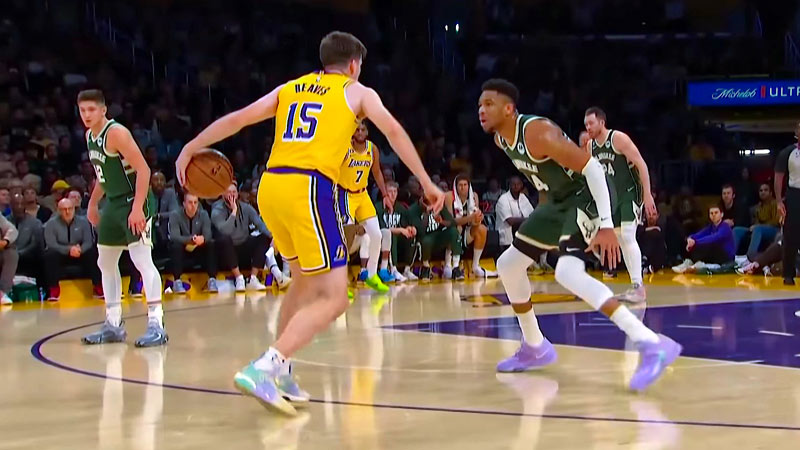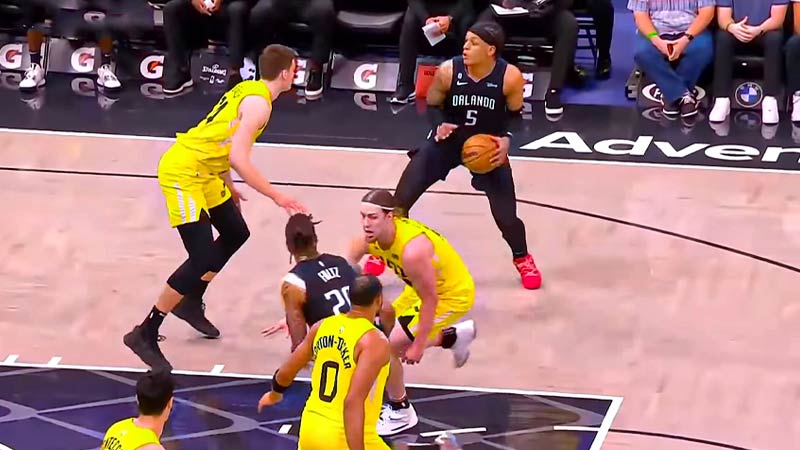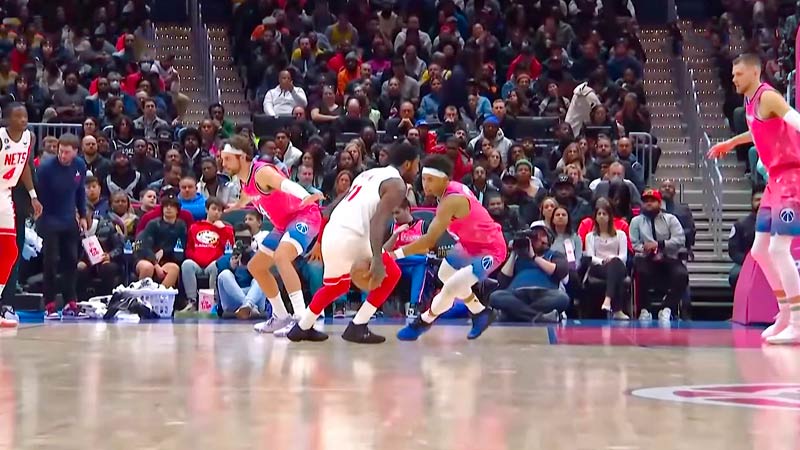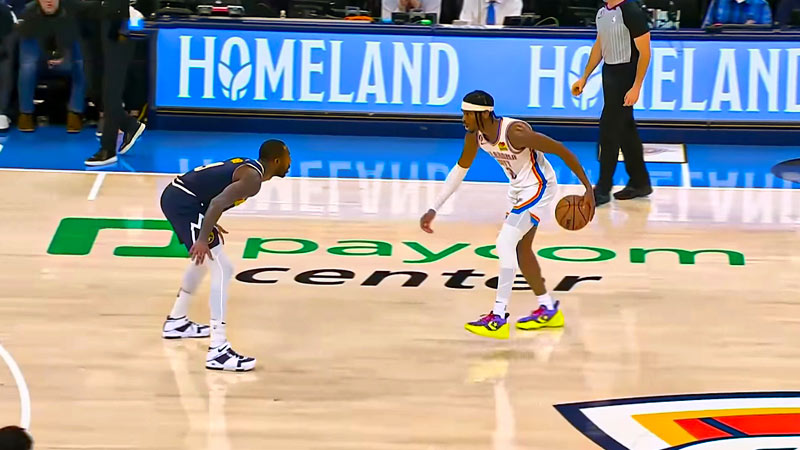Basketball is a dynamic sport that demands a high level of skill and finesse. Among the many fundamental skills required to excel in the game, palming holds a unique place. Palming refers to the technique of controlling the ball with one hand, using a combination of grip, finger control, and hand strength.
It allows players to manipulate the ball with ease, enhancing their ball-handling abilities and opening up a world of possibilities on the court.
Palming in basketball involves gripping the ball in a manner that allows for maximum control while conforming to the rules of the game. When executed correctly, it enables players to perform advanced moves, such as crossovers, hesitation dribbles, and flashy passes.
Palming also plays a crucial role in protecting the ball from defenders, especially when driving to the basket or navigating through tight spaces.
What is Palming in Basketball?
Palming in basketball refers to the technique of controlling the ball with one hand using a combination of grip, finger control, and hand strength. It involves gripping the ball in a manner that allows for maximum control while conforming to the rules of the game.
Palming enables players to manipulate the ball with ease, enhancing their ball-handling abilities and opening up a wide range of moves and maneuvers on the court.
It plays a crucial role in protecting the ball from defenders and executing advanced dribbling techniques, providing players with greater control and versatility in their gameplay.
Palming in NBA
While palming is technically against the rules in basketball, the enforcement of this rule varies, particularly in professional leagues such as the NBA.
In the NBA, palming is often not called by referees unless it significantly disrupts the flow of the game or provides an unfair advantage to the player.
There are a few reasons why palming is not strictly enforced in the NBA. First and foremost, the league prioritizes the entertainment value of the game.
Allowing some leniency when it comes to palming enables players to showcase their skills and creativity, leading to more exciting plays and captivating performances. It adds an element of flair to the game, which has become an integral part of the NBA’s appeal.
Furthermore, the speed and athleticism displayed in the NBA make it incredibly challenging for referees to detect every instance of palming accurately.
The nature of the game, with its quick transitions and complex movements, often results in moments where palming can go unnoticed or deemed insignificant compared to other violations.
Additionally, the NBA has a long history of adapting its officiating standards to match the evolving style of play. Over time, certain techniques and moves have become more accepted, including a certain level of palming. This flexibility in enforcement allows players to exploit their skills and bring innovation to the game.
It’s important to note that while palming is not strictly called in the NBA, there are still limits to what is considered acceptable.
If a player excessively palms the ball or uses it to gain an unfair advantage, it can result in turnovers or offensive fouls. Referees are tasked with maintaining a balance between allowing players to demonstrate their talents and ensuring fair play.
What Happens When A Player Palms A Ball?

When a player plays a ball in basketball, several things happen. Firstly, they gain better control over the ball, allowing them to manipulate it with precision and finesse.
Palming enables players to execute advanced moves, such as crossovers, hesitation dribbles, and behind-the-back passes, enhancing their ability to create scoring opportunities and deceive defenders.
Additionally, palming enhances a player’s grip on the ball, reducing the chances of turnovers and improving their overall ball security. It also provides stability and balance, making it easier for players to navigate through tight spaces or while driving to the basket.
In essence, palming empowers players with greater control, creativity, and versatility on the court.
How to Palm A Ball in Basketball?

Palm control is a skill that can greatly enhance a player’s ball-handling abilities in basketball. It allows for better control, maneuverability, and the ability to execute various moves on the court. Here are six steps to help you develop and improve your palming technique:
Step 1: Stretch Your Hand for Flexibility
Before diving into palming exercises, it’s crucial to warm up and stretch your hand muscles for increased flexibility. Start by extending your fingers as wide as possible and holding the stretch for a few seconds.
Then, flex your fingers into a fist and release, repeating the motion several times. Gently rotate your wrists clockwise and counterclockwise to loosen them up. These stretches will help prevent injuries and prepare your hands for the palming exercises.
Step 2: Training for A Strong Grip
To effectively palm a basketball, you need a strong grip. Strengthening your hand muscles is essential for developing the required grip strength. There are several exercises you can incorporate into your training routine to achieve this. Grip trainers, stress balls, and handgrip exercises with resistance bands are effective tools for building hand strength.
Additionally, exercises like finger push-ups, where you lift your body weight using your fingers, can significantly strengthen your grip. Consistent practice and gradual progression will gradually improve your grip strength over time.
Step 3: Line the Fingers up with the Ball’s Grooves
When attempting to palm a basketball, it’s important to position your fingers correctly to optimize grip and control. Start by placing your hand on top of the ball, with your fingertips aligned with the ball’s grooves.
The grooves provide natural channels for your fingers to rest comfortably and increase your control over the ball. Aligning your fingers with the grooves ensures that your grip is secure and stable, minimizing the chances of losing control during dribbling or other moves.
Step 4: Use Your Thumb and Fingers to Grip the Ball
Once your fingers are aligned with the grooves, use your thumb and fingers to create a firm grip on the ball. Your thumb should be positioned on one side of the ball, while your fingers, spread slightly apart, should be on the other side.
The pads of your fingertips should be in contact with the ball’s surface, providing additional control and stability.
Experiment with different finger placements to find the most comfortable and secure grip that works for you. It’s important to remember not to grip the ball too tightly, as it may hinder your fluidity of movement and control.
Step 5: Squeeze the Ball and Practice It
To strengthen your palming technique, practice squeezing the ball firmly with your hand while maintaining control. This exercise helps develop your finger strength, reinforces muscle memory, and enhances your overall grip.
Start with a stationary ball, applying gradual pressure with your fingers and thumb. As you become more comfortable, try squeezing the ball while moving it from hand to hand or executing dribbling drills.
The goal is to develop the ability to maintain a secure grip on the ball while still having the dexterity to perform various basketball maneuvers.
Step 6: Try for A Fake Pass
A fake pass is an effective move that incorporates palming to deceive defenders and create scoring opportunities. To execute a fake pass, position the ball in your palming hand and simulate a pass by extending your arm as if you were about to release the ball.
However, instead of releasing it, quickly bring the ball back to your grip while maintaining control.
The key is to sell the fake pass convincingly to deceive the defender and create an opening to drive to the basket or make a different play. Practicing this move will enhance your palming skills while adding a deceptive element to your offensive repertoire.
By following these steps and consistently practicing, you can improve your palming technique in basketball. Remember to focus on flexibility, grip strength, finger alignment, and controlled squeezing of the ball. Palming is a skill that takes time to develop, so be patient and persistent in your training.
As you progress, you’ll notice enhanced control, maneuverability, and the ability to execute advanced moves on the court. Mastering palming will add another dimension to your game, allowing you to excel in various aspects of ball handling in basketball.
The Significance of Palming in Basketball

The significance of palming in basketball cannot be overstated. It is a skill that enhances a player’s ball-handling abilities and opens up a multitude of opportunities on the court. Here are some key reasons why palming holds immense significance in basketball:
Ball Control
Palming allows players to have better control over the ball. By securely gripping the ball with one hand, they can navigate through traffic, protect the ball from defenders, and execute various moves with precision.
This level of control is crucial for players, especially when facing aggressive defensive pressure or when trying to create scoring opportunities.
Maneuverability
Palming enhances a player’s ability to maneuver on the court. With the ball securely in their hand, players can change direction quickly, perform crossovers, and execute dribble moves with greater efficiency.
This freedom of movement allows for better offensive options and creates mismatches against defenders.
Deception
Palming adds an element of deception to a player’s offensive repertoire. By utilizing palming techniques, players can fake passes, perform hesitation dribbles, and execute quick changes in speed and direction.
These deceptive moves can leave defenders off-balance, creating scoring opportunities for the player or their teammates.
Creative Plays
Palming enables players to showcase their creativity on the court. With better ball control, players can experiment with different dribble moves, passes, and shots.
They can incorporate unique and unexpected maneuvers into their game, making them unpredictable and difficult to guard.
Style and Flair
Palming has become an integral part of the style and flair associated with modern basketball. Players who possess exceptional palming skills often captivate audiences with their flashy dribbling displays. This not only entertains fans but also helps promote the sport and generate excitement.
Palming plays a significant role in basketball by enhancing ball control, maneuverability, deception, and creativity. It empowers players to showcase their skills and brings excitement to the game.
Aspiring basketball players should strive to develop their palming abilities as part of their overall ball-handling repertoire, as it can elevate their performance and make them more versatile on the court.
FAQs
Is palming legal in basketball?
Palming is technically against the rules in basketball, as it involves controlling the ball with one hand in a manner that exceeds what is considered a legal grip. However, the enforcement of this rule varies, especially in professional leagues like the NBA.
Can anyone learn to play basketball?
With dedicated practice and training, anyone can develop the ability to play basketball. It requires improving hand strength, and flexibility, and mastering the proper technique of gripping the ball to achieve better control.
Does palming give an advantage to players?
Yes, palming gives players a distinct advantage on the court. It enhances their ball control, allowing them to execute advanced moves, protect the ball from defenders, and create scoring opportunities. Palming adds an element of deception to a player’s offensive repertoire.
Are there any disadvantages to palming?
While palming can be advantageous, it can also have drawbacks if used excessively or improperly. Over-reliance on palming can lead to turnovers, as it increases the chances of losing control of the ball. Additionally, excessive palming can result in offensive fouls if it provides an unfair advantage.
Can palming be used by all positions on the basketball court?
Yes, palming is a skill that can benefit players in all positions. Guards can use it to navigate through defenders and create scoring opportunities, forwards can utilize it to protect the ball while driving to the basket, and centers can employ it for better control in the low post. Palming is a versatile skill that transcends positions.
Bottom Line
Palming in basketball is an art that requires practice, technique, and coordination. It offers players an advantage in terms of ball control, maneuverability, and deception.
While the rules regarding palming may vary, developing this skill can significantly enhance a player’s performance on the court.
By following the steps outlined and dedicating time to practice, players can improve their palming abilities and take their game to new heights. So, grab a ball, start training, and unlock the power of palming in basketball.
Thank you for your time.







